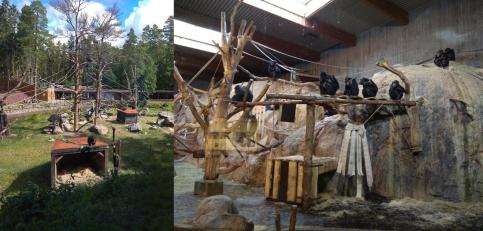Materials & Methods
Animals & Site
A group of 20 captive chimpanzees (Pan troglodytes) at Kolmården Wildlife Park in Sweden were studied. During data collection, the chimpanzees had controlled access in three sites: the inside exhibit, the outside exhibit and off-display group cages. In the summer period, they spent most of their time in the outside exhibit. The outside exhibit included wooden lodgings that provided shade and protection (e.g. from rain). In the winter period, they spent most of the time in the inside exhibit, and they had access to the outside one only for a short period of time, when the weather was good. No observations were done in the cages.

Experimental setup
Initially, there was a three-week period of learning how to recognize all the 20 individuals, while at the same time the chimpanzees would get used to the presence of the observer. After this period, two study periods followed: Period 1 (25 June- 18 August, outdoors) and Period 2 (1 October- 20 November, indoors). Scan sampling with 10 minutes’ interval was used to record the behaviour of all animals at the same time. Each session lasted 2 hours and was repeated twice per day (morning and afternoon). Each period resulted in 138 hours of observations. Different types of enrichment were offered to the chimpanzees in both periods. Each type of enrichment was present for a few days per week and between these days no enrichment was offered. In total, enrichment was present for 48 hours in the outdoor exhibit and 40 hours in the indoor exhibit. The type of the enrichment and the days that it was offered were based on an enrichment schedule made entirely by the zookeepers.
The behaviours that were recorded were the following: A. Associative (proximity), B. Affiliative (allogrooming, play, simultaneous grooming) and C. Agonistic (displace, display, fight, submission, threat, other aggression). Proximity and play included two or more individuals (dyadic and group mode), display and interacting with enrichment included one individual (linear mode) and allogrooming, simultaneous grooming, displace, submission, threat and other aggression included two individuals (dyadic mode).
In total, 37 different enrichments were offered. The enrichments that were used belonged to the following categories:
-1: sensory
-2: object-based
-3: social
-4: food-based
-5: species-specific
Some days more than one enrichment were used combined.

Data analysis
A. Effect of the enclosure and enrichment on chimpanzees’ social interactions
In order to compare the effect of the exhibit on the chimpanzees’ social interactions, we applied a One Sample Chi-square test in SPSS for each behaviour. One Sample Chi-square test was also applied to compare the social interactions of the group between the enrichment and the no enrichment days, in the indoor and outdoor exhibit, separately. Enrichment was present for 48 hours in the outdoor exhibit and 38 hours in the indoor exhibit and the no-enrichment period was longer that the enrichment one. For this reason, only data from a part of the no-enrichment period were included in this test in order to compare the social interactions between equal amounts of time (enrichment-no enrichment days) both outdoors (48 hours each period) and indoors (38 hours each period). On the enrichment days, enrichments that belonged to the five different categories were used. Unfortunately, we only had sufficient data from the food-based enrichment in order to find if and how the type-category of enrichment affected the social interactions of the group. One Sample Chi-square test was used, to compare the social interactions of the group between the food-based enrichment and the no enrichment days, in the indoor and outdoor exhibit, separately. Food-based enrichment was present for 17 hours in the outdoor exhibit and 23 hours in the indoor exhibit and the no-enrichment period was longer that the enrichment one. For this reason, only data from a part of the no-enrichment period were included in this test in order to compare the social interactions between equal amounts of time (food-based enrichment-no enrichment days) both outdoors (17 hours each period) and indoors (23 hours each period).
B. Social and hierarchical structure analysis (SOCPROG)
We used SOCPROG, a set of programs that analyses data on animal associations, to perform social and hierarchical structure analysis. We used proximity (symmetric associations), allogrooming (asymmetric interactions) and agonism (asymmetric interactions) in these analyses. Agonism included the following aggressive behaviours: aggression, threat, submission and displace.
We calculated association and interaction indexes for all dyads across associative matrixes (symmetric) and agonistic, allogrooming matrixes (asymmetric). An association index estimates the proportion of time individuals spend together in proximity (‘simple ratio’) and an interaction index estimates the proportion of time individuals interacted with each other (‘simple ratio’). We then used these matrices in order to do a hierarchical cluster analysis in SOCPROG, which illustrates the clustering of relationships between individuals. We conducted a test for preferred and avoided relationships and a test for reciprocity. Finally, we used SOCPROG, to analyse the dominance hierarchy in the chimpanzee’ group. We used three different methods: The ‘I&SI’ method of de Vries (1998), Brown’s (1975, 86) method and Crow’s (1990) method.
Responsible for this page:
Director of undergraduate studies Biology
Last updated:
05/22/20
